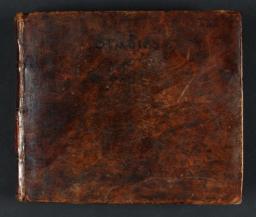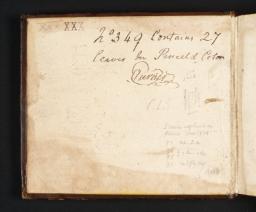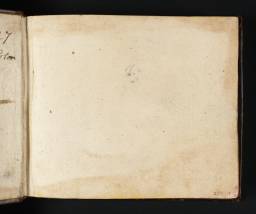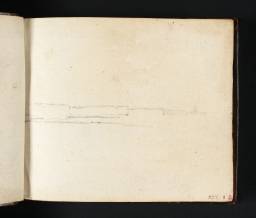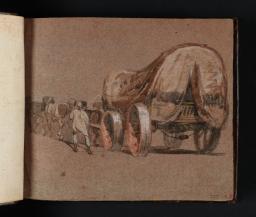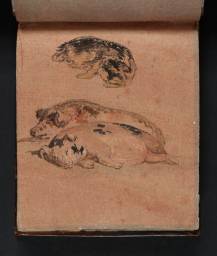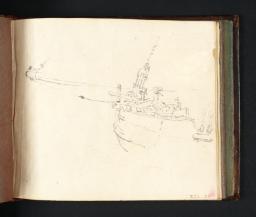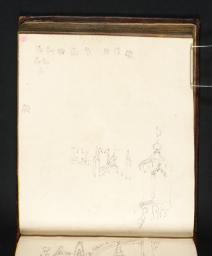Turner Bequest XXX 1–96a
Sketchbook bound in boards covered in brown calf leather; gold-tooled red leather label on spine inscribed ‘VIEWS’
96 leaves and pastedowns of white laid and wove paper, and blue laid paper, the latter often prepared with a red-brown wash; white wove paper watermarked ‘J WHATMAN 1794’; page size 108 x 126 mm
Inscribed by Turner in ink ‘Studies | near | Brighton’ on front cover (D40759)
Inscribed by Turner ‘22. Studies, Brighton’ on label (now lost, but presumably once glued to the spine)
Numbered 349 as part of the Turner Schedule in 1854 and endorsed by the Executors of the Turner Bequest inside front cover (D40760)
96 leaves and pastedowns of white laid and wove paper, and blue laid paper, the latter often prepared with a red-brown wash; white wove paper watermarked ‘J WHATMAN 1794’; page size 108 x 126 mm
Inscribed by Turner in ink ‘Studies | near | Brighton’ on front cover (D40759)
Inscribed by Turner ‘22. Studies, Brighton’ on label (now lost, but presumably once glued to the spine)
Numbered 349 as part of the Turner Schedule in 1854 and endorsed by the Executors of the Turner Bequest inside front cover (D40760)
Accepted by the nation as part of the Turner Bequest 1856
Exhibition history
References
Finberg remarks:1 ‘the only sketch-book which can be assigned to [1796] is a small pocket-book bound in red leather [sic], on which he has written in ink on one of the covers: “Studies near Brighton”. ... The two best drawings in the book are studies of a sow suckling her litter [folios 4 recto, 96 verso: D00838, D00839; Turner Bequest XXX 93, 94]. These are extremely sensitive in execution, but I doubt if they are quite worthy of the exuberant praise Ruskin lavished on them; he thought Rembrandt’s etching of a pig “approaches” one of them, “but by no means equals it.”’ There are many blank pages, and Finberg thought most of the work ‘slight and timid in execution’, dealing with ‘an odd jumble of subjects ... in such marked contrast to the confident and decisive drawings made in the previous summer [in the South Wales and Isle of Wight sketchbooks (Tate; Turner Bequest XXVI, XXIV)] that some explanation of the change is required.’ His suggestion is that since the sketchbook looks like ‘the work of an invalid’, Turner may have ‘been seriously ill this year, that he had gone to Brighton only to regain his health and strength’. It is odd, if that is the case, that he did not go to Margate where he is known to have had relatives; and indeed, the first sketch in the book shows Reculver Cliffs near Margate, while folio 36 verso (D00770; Turner Bequest XXX 35) has a drawing at North Foreland, near Broadstairs. These suggest that the artist’s label does not tell the whole story. Other drawings are of architectural details at Chichester; see folios 27 recto, 28 recto, 33 recto and 34 recto (D00755, D00757, D00763, D00766; Turner Bequest XXX 26, 27, 32, 33).
It may also be pointed out that the drawings in this book have elements in common with several loose sheets of blue paper depicting shore scenes, shipping and figures on the south coast, which have been thought to belong to a stay in Brighton, though, as is argued here (in the Introduction to the grouping of separate sheets within this section of the catalogue) they seem for the most part to have been done in Margate. They are on the whole more substantial than the work in this sketchbook, and are generally dated to the following year; but the similarities should be noted and the possibility that they might represent further work at Brighton borne in mind. A further indication that Turner’s energies were hardly in decline is the list of etching materials written out on the inside of the back cover. This suggests a returning interest in a medium that he had thought about but not pursued in about 1791–2; see the verso (Tate D40213) of Tate D00057 (Turner Bequest V D), and introductory remarks to the Bristol and Malmesbury sketchbook (Tate; Turner Bequest VI) in the ‘Bristol and Malmesbury 1791’ section of the present catalogue. Two recently discovered fragments of etchings that seem to be Turner’s own work (Tate D41457, D41464; Turner Bequest XXXII Fv and XXXII Cv respectively) would appear to confirm this revived interest.
Some of the studies of figures, singly and in groups, anticipate the conscious ‘collection’ of local costumes and types embarked on during the Scottish and Swiss tours of 1801 and 1802 in the Scotch Figures and Swiss Figures sketchbooks respectively (Tate; Turner Bequest LIX, LXXVIII). Wilkinson thought that the book was ‘the pair of the “Wilson” [sketch]book’ (Tate; Turner Bequest XXXVII) with its grey-brown leaves, and that ‘what Turner was doing with his free time during 1796 and 1797 was collecting subjects for paintings.’ It can be asserted without fear of contradiction that Turner was almost invariably collecting such subjects, and the Wilson book actually includes copies after other people’s paintings (notably Wilson’s), which could not have constituted potential ‘subjects’ for Turner. But Wilkinson’s point is a reasonable one: the two books, like the loose sheets already mentioned, cannot be much separated chronologically; and the studies in gouache towards the back of this Studies near Brighton book are close in spirit to several in the Wilson book.
Finberg records a label ‘on back’ (i.e. the spine), inscribed by Turner ‘22 Studies, Brighton’.2 This is no longer extant. John Ruskin’s endorsement on the wrapper, also no longer extant, is recorded by Finberg: ‘349 invent. Two studies of pigs cut out. One or two interesting waggons and sheep left.’3
Technical notes
How to cite
Andrew Wilton, ‘Studies near Brighton Sketchbook 1796’, sketchbook, May 2011, in David Blayney Brown (ed.), J.M.W. Turner: Sketchbooks, Drawings and Watercolours, Tate Research Publication, November 2014, https://www

